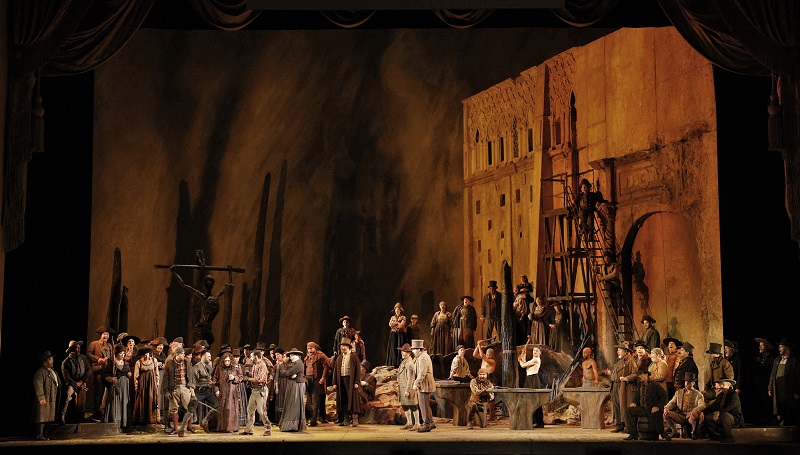
A Tightened Vengeance Opera
The current drama of long-simmering vengeance “Il Trovatore” being a riveting experience is merely part of the story. The SF Opera managed to tighten the action greatly by eliminating two of the three intermissions, playing it in just 2.5 hours—a midweek blessing, especially for those heading to their offices in the morn. One of the heroes was the revolving stage—-yes, stage, take a bow—-enabling lightning-fast scene changes merely by a huge wall rotating from side to side, thereby bridging the cumbersome total of eight scenes that Verdi called for.
The stellar singing at the Sept. 12 season opener was focused on two figures: The vengeful villain and Count (baritone George Petean) and the focal personage, the doomed heroine Leonora (soprano Angel Blue, a Grammy award winner). Blue’s well-focused tones, amidst some less focused ones around the stage, could melt the stones of the Spanish fortress in which she’s caught. In the later going, her attractive lirico-spinto voice had to progress to some deft coloratura that she had never had to show in her previous “Porgy and Bess.”
In his engrossing SFO debut the Romanian baritone Petean showed poise, power and proficiency as the Count di Luna, who very nearly manipulates the fetching captive Leonora into his bed until she poisons herself to avoid the proverbial fate worse than death.
Also in the opera’s focal pas de quatre is tenor Arturo Chacón-Cruz, as the attractive young lover Manrico. Though he is inclined to over-sing in order to fill the giant opera house, he climbed to the high C resoundingly at the end of his show-stopper, “Di quella pira” (From this Pire). Mezzo Ekaterina Semenchuk underplayed the gypsy-mystic role of the Roma, Azucena. Stage Director Roy Rallo moved even the largest crowd scenes about as if on his private chessboard.
The support group was dazzling, headed by conductor Eun Sun Kim, the troupe’s first female music director in the century-old history. She could bring the most sensitive moments out of her pit orchestra as well as the resounding ones like the famous “Anvil Chorus,” in which the robust men’s chorus showed its strength and mettle.
MUSIC NOTES—This 19th-century “Troubador” opera portrays a savage era, with burnings at the stake, executions, revolt, alleged witchcraft and carnal desire, reflected in the revolting mob portrayed in the opening-curtain art, in all its untamed gore (created by the ubiquitous Scottish producer, David McVicar, with stage director Charles Edwards)….Winnowing down intermissions to just one, as in Broadway musicals, has long been a lobbying point by local philanthropist and opera fan Gordon Getty. Doing so requires multiple approvals by tiring singers, stage crews—-and the sets themselves, known to balk at times if speed-ups are involved!
Mark this one among the opera world’s more incredible scenarios. A crone unjustly accused of witchcraft extracts her revenge by killing a baby, but erroneously, such that at the end Count di Luna unwittingly sends his own brother to the executioner.
VERDI’S OPERA ‘IL TROVATORE,” in Italian, with supertitles, playing Sept. 12-Oct. 1, Opera House, San Francisco. For info: (415) 864-3330 and online at www.sfopera.com. Live-streamed Sept. 21-23.